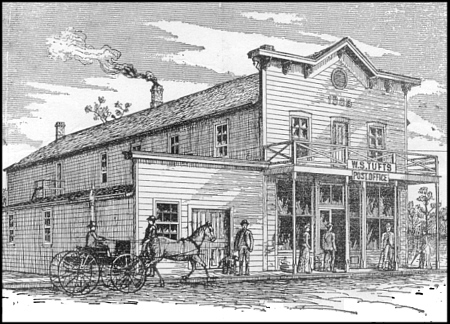Follow the
River.......
Historical
Recollections by Lula Mae Stewart
Contributed by the
Greenwood Public Library, Transcribed by
Janet Schwarze
|

General Store of W.S. Tufts, Withee This building has been recently
enlarged, and is now one of the largest store buildings in the county,
being 70 feet in width by 100 feet in length. Mr. Tufts carries an immense
stock of general merchandise. His constantly increasing trade, caused by
the settling up of this locality, has compelled him from time to time to
enlarge his buildings until he now has an establishment that would be a
credit to a larger town than Withee. Concerning Mr. Tufts himself, see
portrait elsewhere in this book. (Reprinted from an 1890 book) |
Early History of Withee
I will write here a little of the early
history of Withee I am sure some of this has been written before. The first
permanent settler who came to Withee was George Richards. About this time a
David Goodman settled here also. Wm. Tufts came where in 1875. He worked as a
woods superintendent for N. H. Withee who was an original logger, who worked
with D. J. Spaulding.
The first general store was built in
Withee in 1881. a general store had every thing in stock that the loggers and
their families might need. About this time Felix Douphner came to the town of
Hixon. In 1896 he moved to the village of Withee. Where he operated a
hotel, there was a real need for a hotel at this time, as people needed a place
to stay and rest before continuing on their journey.
Around 1882 a depot was built in
Withee. Withee was named after N. H. Withee. The old Withee farm was located on
Popple river the present site of the Clark County Health Care Center. The second
place of business in Withee was a Saloon, where the loggers could go and have a
few drinks and swap stories.
The first school was built around 1883.
Mr. Tufts was the first Postmaster in Withee. In 1894 a Sunday school was built.
About this time Danish settlers started coming to Withee.
In 1882 John Owens purchased the
Spaulding mill. From that time on the saw mill provided employment for the
settlers in the area. I remember some of the old timers telling how they walked
five rnile5 to work. Eating a lunch of cold beans and frozen sandwiches. There
were many more mill towns around the country, Redville, Clark, Maplehurst and
more. With the growth in the area and people starting to farm Cattle Buyers came
to the Withee area.
Ben Krom was one of the first Cattle
Buyers to come to the Withee area. Later Guy Stewart came to the Wolters corner
area from Iowa bringing his family with him. As his sons grew up they joined him
in the business. At one time there was a store at Wolter's corners. The last
couple who operated the store was Bill and Edith Neimi. It has since been torn
down. The old cheese factory building still stands. Many things have changed
since we left that area. New people have moved in and the older generation have
passed away leaving behind the farms they worked to hard to build.
They left behind stately old buildings
and rich farm lands. The buildings were built from lumber sawed from the logs
cut from the land. In many of the older barns the walls were built from large
rocks that were hauled in on a stone boat. They were laid in place one by one
with mortar in between to hold them together. Large timbers were cut and hewed
to fit and cemented to the top to support the hay mow. Which was used to store
bay and straw. There are still a number of these old barns around the country
side but they too will be gone some day as modern structures replace the old.
Many older houses also have these walls, the basements were used to store
vegetables and a winters supply of apples I remember as a child the aroma of
apples always greeted us when we opened the basement doors. In these days they
were called cellars.
The Story of Clark
Clark was once a thriving community in
the early days. Located in the north east corner of the township of Hixon. Today
there is little left of this once thriving community. About all that remains is
the store and lots of memories of days gone by.
This is a look at the businesses and
industry that once made Clark a thriving community. In 1903 the first
settlers came to Clark. The area was covered with thick forests. The nearest
town was Maplehurst. These early settlers were isolated from the outside world,
as there were no roads into that area. Their only access to the outside world
was Black River. From Maplehurst the early settlers could find roads to Medford
and Withee. Where they could purchase the things they needed to survive. In the
spring of 1905 the Soo Line put a right of way from Owen to Ladysmith and by
1908 had a line from Owen to Duluth.
The settlers organized themselves to
build a school. This was around 1908 the first school was little more than a
wood shed in fact it later became a wood shed when a permanent building was
erected. The first teacher was Mamie Douglas. She had five children in her
school. The children had to walk to school over old logging roads to Maplehurst
three miles away. In winter they had to carry a lantern to light their way and
keep the wolves away.
|
 (Click to enlarge)
(Click to enlarge) |
Table of
Contents< >Next Page


